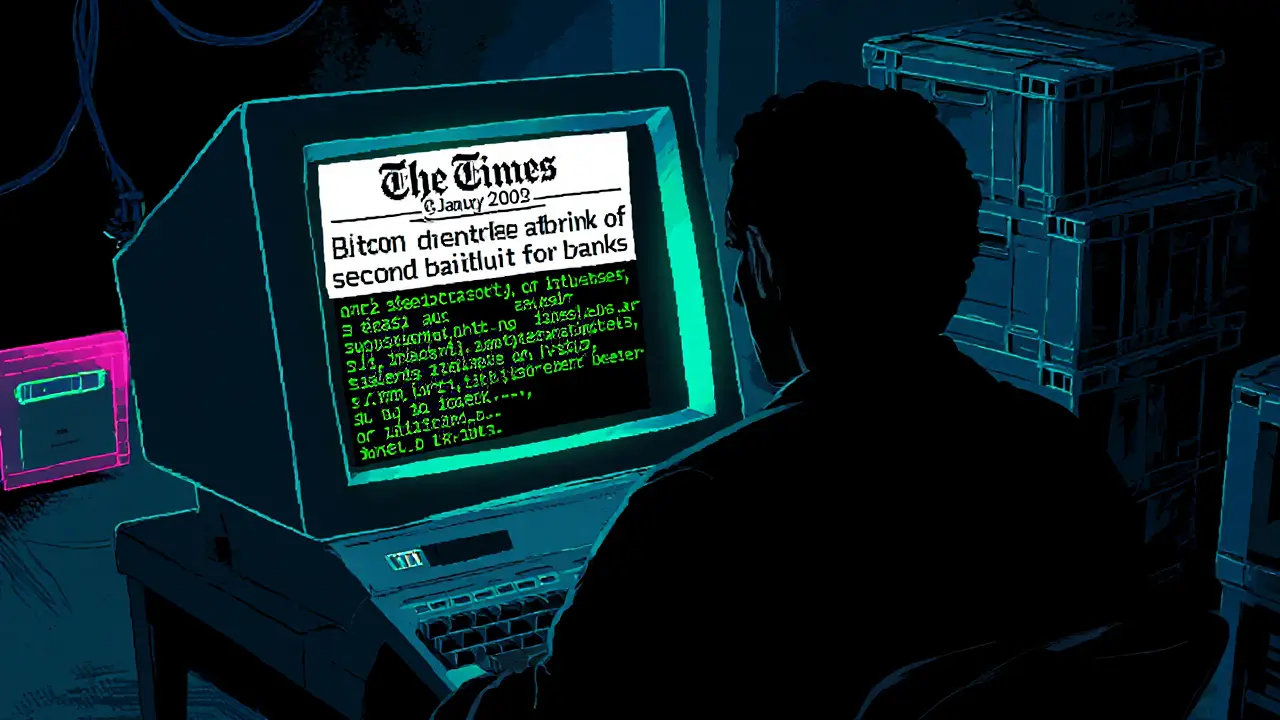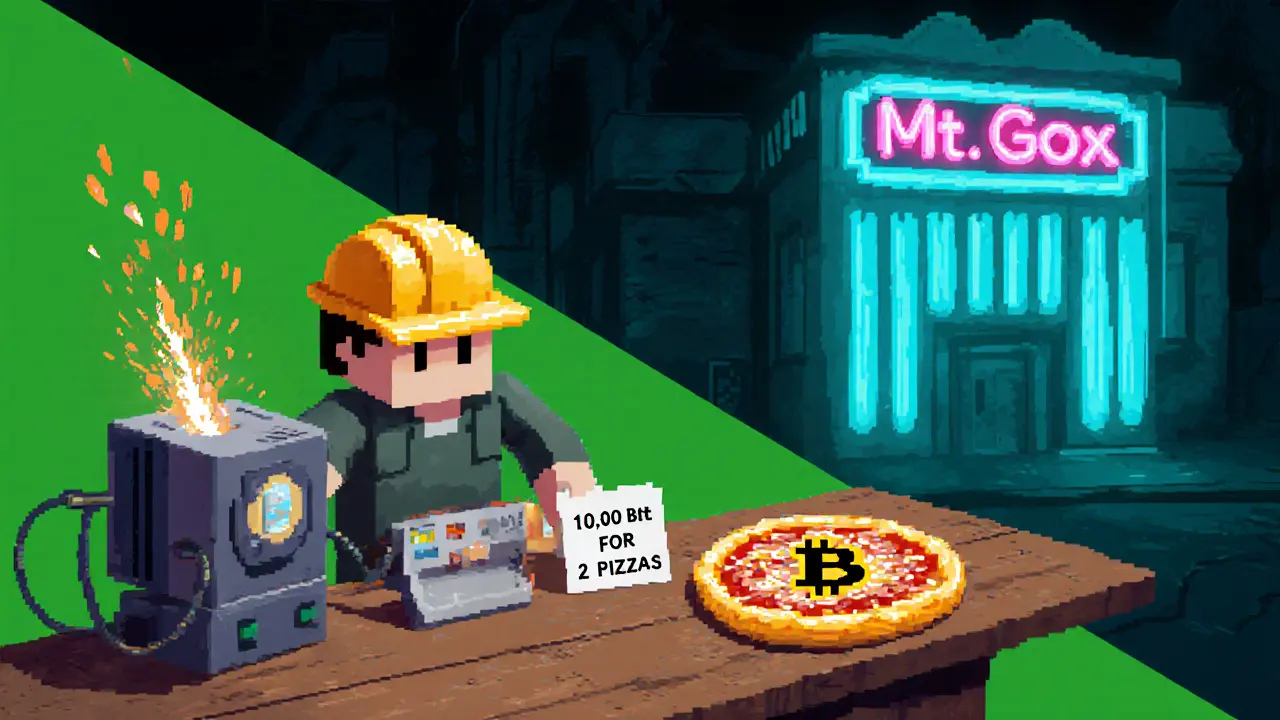Posted By Tristan Valehart On 26 Jan 2025 Comments (14)

Bitcoin Milestone Timeline
Explore the key moments that shaped Bitcoin from its inception to today's global phenomenon.
Did You Know?
The first Bitcoin transaction occurred just 13 days after the genesis block was mined!
The term "Bitcoin Pizza Day" commemorates the first real-world purchase using Bitcoin.
Each halving reduces the block reward by half, ensuring a decreasing supply of new bitcoins.
Bitcoin's Core Principles
Bitcoin's success stems from combining cryptographic proof-of-work, a peer-to-peer network, and a capped supply of 21 million coins.
When the world still trusted banks to keep money safe, a mysterious figure released a piece of code that would rewrite the rules of money. The result? Bitcoin - the first true cryptocurrency, built on a decentralized ledger and launched in the midst of the 2008 financial crisis.
Genesis Block: The Birth Certificate of Bitcoin
On January 3, 2009, the very first block of the Bitcoin network was mined. In the block’s coinbase parameter, the creator embedded the text:
"The Times 03/Jan/2009 Chancellor on brink of second bailout for banks"
This hidden headline served two purposes: a timestamp proving the block could not have been created earlier, and a political statement about the banking failures that spurred the project.
Genesis block is the foundational block that anchors the entire blockchain, making every subsequent transaction traceable back to this moment.
Who Is Satoshi Nakamoto?
The name behind the code remains a puzzle. In October 2008, a post titled "Bitcoin: A Peer‑to‑Peer Electronic Cash System" appeared on a cryptography mailing list, authored by Satoshi Nakamoto, a pseudonym that could represent an individual, a group, or even a government agency. After a few months of shepherding the software, Nakamoto vanished, leaving the community to maintain and improve the network.
Technical Backbone: SHA‑256, Proof‑of‑Work, and the Blockchain
Bitcoin’s security hinges on three core components:
- SHA‑256 is a cryptographic hash function that transforms any input into a 256‑bit output. Miners repeatedly hash block headers until the result falls below a network‑adjusted target.
- Proof‑of‑Work (PoW) is the consensus algorithm that forces participants to solve these hash puzzles, preventing double‑spending without a central authority.
- Blockchain is a growing chain of blocks, each containing a batch of transactions and a reference to the previous block’s hash, creating an immutable ledger.
Together, they ensure that once a transaction is recorded, altering it would require re‑mining every subsequent block - a computationally infeasible task.
Early Milestones: From $0.003 to Pizza
The first recorded price of Bitcoin was $0.003 on March 17, 2010. A few weeks later, on May 22, 2010, an event now known as "Bitcoin Pizza Day" took place. Pizza transaction involved programmer Laszlo Hanyecz paying 10,000 BTC for two large pizzas, effectively demonstrating that Bitcoin could be used for real‑world purchases.
Later that year, the first cryptocurrency exchange, Mt. Gox, launched on July 18, 2010, providing a platform for users to trade Bitcoin for fiat currencies.

Precursors That Paved the Way
Bitcoin didn’t appear in a vacuum. Several earlier attempts tried to solve digital cash problems but fell short of mass adoption:
| Project | Year | Key Feature | Why It Failed |
|---|---|---|---|
| eCash (DigiCash) | 1995 | Bank‑issued encrypted notes | Required trusted banks, limited adoption |
| b‑money | 1998 | Anonymous distributed cash | No workable implementation |
| Bit Gold | 1998 | Proof‑of‑Work linked to cryptographic hashes | No network layer, no consensus |
| Bitcoin | 2009 | Decentralized PoW blockchain | Successfully launched and grew |
These projects introduced concepts like cryptographic anonymity and proof‑of‑work, but only Bitcoin combined them with a peer‑to‑peer network, a self‑adjusting difficulty algorithm, and a capped supply of 21million coins.
Halving Events and the Deflationary Design
Bitcoin’s protocol includes a built‑in issuance schedule: every 210,000 blocks (approximately four years), the block reward is cut in half. The first halving on November 28, 2012 reduced the reward from 50BTC to 25BTC, creating scarcity that fuels price appreciation. Subsequent halvings in 2016, 2020, and 2024 continued this trend, reinforcing Bitcoin’s reputation as “digital gold.”
Bitcoin halving is a programmed reduction of new supply that cannot be altered without unanimous network consensus.
Impact on the Financial Landscape
By 2025, Bitcoin has celebrated its 16th birthday and inspired an ecosystem of over 25,000 cryptocurrencies. Traditional finance has taken notice: futures contracts on CME, custody services from banks, and institutional funds allocating a portion of assets to BTC. The original goal - a peer‑to‑peer cash system free from centralized control - sparked debates about monetary sovereignty, regulatory approaches, and the future of money.
Bitcoin also proved a resilient store of value during periods of fiat inflation, offering an alternative anchor for savers in countries with unstable currencies.
Quick Timeline of Key Events
- 2008‑10‑31: Whitepaper released by Satoshi Nakamoto.
- 2009‑01‑03: Genesis block mined, network goes live.
- 2010‑05‑22: First real‑world purchase - 10,000BTC for pizza.
- 2010‑07‑18: Mt.Gox exchange launches.
- 2012‑11‑28: First halving event.
- 2013‑11‑28: Bitcoin reaches $1,000 for the first time.
- 2014‑02‑07: Silk Road shutdown highlights illicit use cases.
- 2020‑05‑11: Third halving cuts reward to 6.25BTC.
- 2024‑04‑30: Bitcoin market cap exceeds $1.2trillion.
Why Bitcoin Still Matters
Beyond being the first cryptocurrency, Bitcoin set the template for blockchain‑based innovation. Its open‑source code invites anyone to audit, improve, or fork the system. The scarcity model, transparent consensus, and global reach make it a unique asset class that challenges traditional notions of money, trust, and governance.

Frequently Asked Questions
What motivated Satoshi Nakamoto to create Bitcoin?
The 2008 financial crisis exposed systemic flaws in the banking system. By embedding the Times headline about a bank bailout in the genesis block, Nakamoto signaled a desire for a trust‑less, decentralized monetary system that bypasses banks.
How does proof‑of‑work secure the Bitcoin network?
Miners compete to solve a SHA‑256 puzzle; the first to find a valid hash adds a new block and receives newly minted BTC plus transaction fees. To alter a past transaction, an attacker would need to redo the work for that block and every block after it, which is computationally infeasible.
What is a Bitcoin halving and why does it matter?
Every 210,000 blocks the block reward is cut in half, reducing the rate at which new bitcoins enter circulation. This built‑in scarcity creates upward price pressure and reinforces Bitcoin’s role as a deflationary asset.
How did the first Bitcoin transaction for pizza happen?
Programmer Laszlo Hanyecz posted an offer on a Bitcoin forum to buy two pizzas for 10,000 BTC. Someone accepted, and the transaction was recorded on the blockchain, marking the first documented purchase using Bitcoin.
Why is Bitcoin considered the first true cryptocurrency?
Earlier digital cash projects lacked a decentralized consensus mechanism, had central points of failure, or never launched publicly. Bitcoin combined cryptographic proof‑of‑work, a peer‑to‑peer network, and a capped supply, achieving global adoption and spawning an entire ecosystem.


Deepak Chauhan
January 26, 2025 AT 10:34The genesis block is more than a technical footnote; it serves as a manifesto against centralized banking 🏦. By embedding the headline about a bailout, the creator signaled a demand for monetary sovereignty. This act resonated across borders, inspiring countless developers to experiment with decentralized finance.
From a philosophical angle, it challenges the notion that value must be issued by nation‑states, positioning Bitcoin as a digital challenge to fiat authority.
Aman Wasade
January 31, 2025 AT 08:06Ah, the glorious tale of a mysterious coder scribbling a whitepaper while the world crashes. One could almost write a romance about the dramatic rise of a currency born from panic. Yet, the timeline reads like a sitcom: pizza, scandals, and unstoppable hype.
Janelle Hansford
February 5, 2025 AT 04:46Hey folks! This overview really nails how Bitcoin’s early milestones sparked a global shift. It’s exciting to see how each event, from the genesis block to the latest market cap, builds on community effort.
Keep exploring – the story is still being written, and every new developer adds a chapter.
Marie Salcedo
February 10, 2025 AT 01:26Great summary! It’s amazing how a simple idea became a worldwide phenomenon.
Bitcoin’s journey shows that innovation thrives when people collaborate.
jit salcedo
February 14, 2025 AT 22:06Look beyond the glossy timeline – the real story is laced with hidden agendas. Every block mined is a silent protest against the elite’s grip on money, a digital uprising whispered in code. Some say the true purpose was never just cash; it was a tool to dismantle the surveillance state.
Remember, the narrative we’re fed is curated; dig deeper, question the motives, and you’ll find a labyrinth of conspiracies buried beneath the slogans.
Ally Woods
February 19, 2025 AT 18:46Not all hype is justified, but the pizza story does prove real‑world use.
Still, many newcomers chase price spikes without understanding the tech.
Kristen Rws
February 24, 2025 AT 15:26The article captures key events well, but it could use more on early adopters.
Also, some minor typos slip through, but the gist is clear.
Fionnbharr Davies
March 1, 2025 AT 12:06From a philosophical standpoint, Bitcoin embodies the principle of trustless agreement. It replaces institutional arbitration with cryptographic proof, reshaping how we conceive value.
Seeing the milestones laid out helps us appreciate how theory gradually became practice.
Andrew McDonald
March 6, 2025 AT 08:46While the timeline is thorough, it glosses over the ethical implications of anonymity.
One must ask: does privacy trump accountability? 🤔
Enya Van der most
March 11, 2025 AT 05:26Bitcoin's story is pure crypto legend!
Latoya Jackman
March 16, 2025 AT 02:06Legends aside, it’s important to keep a measured perspective on its impact.
Megan King
March 20, 2025 AT 22:46Nice recap! I love how each milestone shows the community’s resilience.
Totally motivates me to keep learning about blockchain tech.
C Brown
March 25, 2025 AT 19:26Sure, the market cap hit $1.2 trillion, but let’s not pretend that’s the endgame.
The real question is whether Bitcoin can survive the next regulatory crackdown without losing its edge.
Noel Lees
March 30, 2025 AT 16:06Reading through this chronology reminds us that every milestone was a collective experiment, not just a solitary invention.
When the whitepaper appeared in 2008, it offered a blueprint that anyone could read and improve.
The mining of the genesis block a few months later proved that the concept could be instantiated without any central authority.
Fast‑forward to the infamous pizza purchase, and we see the first tangible use‑case that turned abstract code into a real‑world transaction.
The launch of Mt. Gox introduced market dynamics, teaching early adopters about liquidity and price discovery.
Halving events, occurring roughly every four years, deliberately tighten supply, creating a predictable scarcity that fuels speculation and long‑term holding behavior.
Each price breakthrough, like the $1,000 mark in 2013, acted as a psychological threshold, pulling in new participants and media attention.
Regulatory events such as the Silk Road shutdown highlighted the double‑edged sword of anonymity, prompting debates about illicit use versus financial freedom.
Institutional entry in the 2020s, with futures and custodial services, underscored Bitcoin’s maturation from fringe hobby to legitimate asset class.
Yet, despite its growth, the core principles-decentralization, limited supply, and proof‑of‑work security-remain unchanged, serving as a constant anchor amid market turbulence.
Looking ahead, the community faces challenges: scaling solutions, energy consumption concerns, and potential governmental crackdowns.
Nevertheless, the resilience shown over the past decade suggests that Bitcoin will continue to adapt, inspiring countless off‑shoot projects and redefining notions of value.
In short, the timeline isn’t just a list of dates; it’s a narrative of how a cryptographic idea reshaped global finance and sparked an entire ecosystem of innovation.